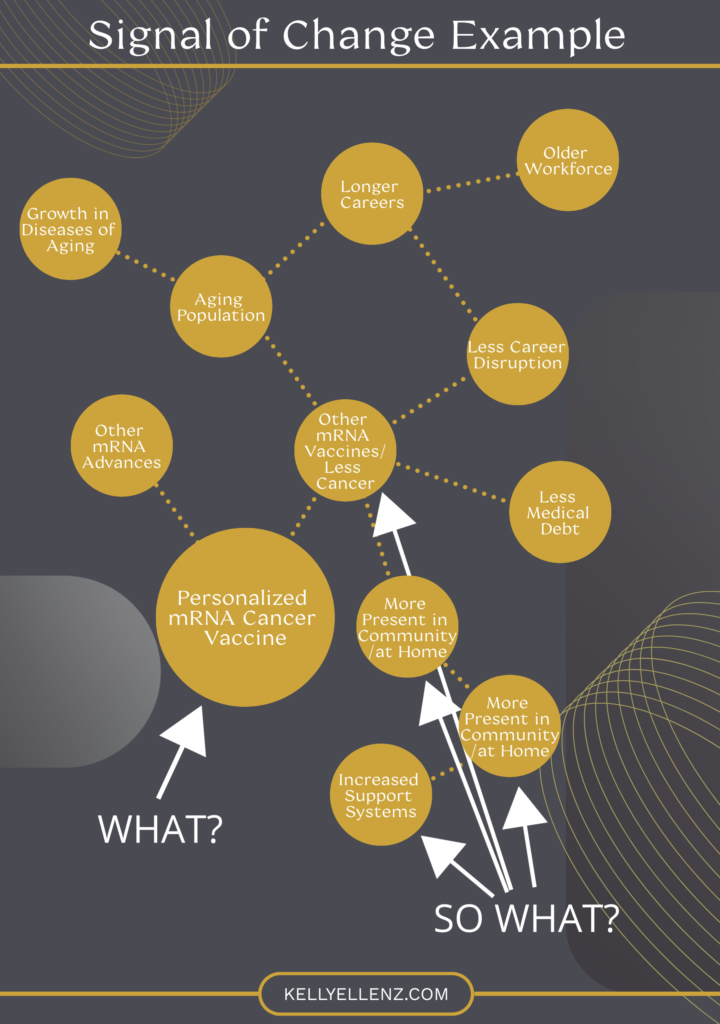Signals of Change: The Cornerstone of Foresight
What is a signal of change?
A signal of change is an indicator of a shift that is occurring or emerging in a particular area. It can be a new technology, a medical advancement, a new patent, the way a society is adapting to become more resilient, a change in policy, a shift in an industry. Signals of change are one-off and can be subtle or overt.
Often, we dismiss signals of change because they are so different. That’s our bias talking.
Why do we talk about signals of change?
At first glance, many people will think talking about signals of change is a waste of time because the signals feel so small, isolated, even unimportant. But that urge is also our bias talking (more on biases here!). Our biases make us super-efficient. Biases make us assume the most general answer, the most obvious answer, the most repeated experience.
The future starts small. The future happens long before most people recognize it. That’s why identifying signals is a skill. It requires slowing down, opening your mind to possibilities and a future that’s different than anything we’ve experienced already. When we talk about signals, we don’t just discuss what the signals is, but what the signal means.
What’s an example of a signal of change?
First personalized mRNA cancer vaccine: There are a handful of mRNA cancer vaccines in trials in Europe. One such trial is for lung cancer. The “what” for this signal is pulled directly from the article, the vaccine “instructs the body to hunt down and kill cancer cells – then prevents them ever coming back. Known as BNT116 and made by BioNTech, the vaccine is designed to treat non-small cell lung cancer (NSCLC), the most common form of the disease.”
Implications of change: The “so what.”
Generally, I’ll introduce the signal and explain what it is, then I’ll talk about what it makes me feel or think about. These are the “so what,” or the implications of this change.
Discussing the “so what” is when diverse perspectives really help. I can talk about what it made me think of, but adding in other people’s ideas is what makes the conversation really rich, nuanced, and interesting. It helps us imagine wider implications and a more robust future. I
n this case, the first thing I did was think back to those COVID mRNA vaccines, where scientists were talking about what an advance in science these vaccines were, and how the COVID mRNA vaccine was only the beginning. I also start to think about not only eliminating lung cancer, but eliminating other types of cancer, or other mRNA-based medical advancements.

I start to think about how if one in five people (mentioned in the article) will have cancer, how might their lives be different now, and society as a whole? How will financial futures differ without disruptive chemotherapy treatments. Less medical debt, less career disruption, more ability to be present at home and in supportive communities.
I also think about people living longer, and how a longer life might mean workers who need to work longer, and what will that do to the workforce? How would the workplace adapt with more older employees? What new diseases of age might become more prevalent? How might those treatments need to shift to manage a society that lives longer? How might it adjust the number of children the average woman needs to have to maintain the current population levels?And those are just some of my first thoughts! If I bring this signal to a more diverse group to collaborate on a discussion, the example shown would be much more complex. And that’s a good thing! We want to consider how the future might be different, especially if the trials are successful and further development means everyone gets a cancer vaccine as a child or young adult, rather than waiting until diagnosis.
We’ve discussed the signal of change, now what?
The next step is asking “now what?” This is where you will think about what you’ll do with this information. Human Resources departments are probably already thinking about supporting aging populations because workers are already working longer since we’re living longer due to other medical advancements (screenings, chronic disease medications, regulations to make society safer, etc.). A workplace with an aging population might need different type of healthcare or benefits packages, or might eventually consider how long a workday is or how breaks or injuries or limitations might be accommodated. Adding in mRNA cancer vaccines probably doesn’t require an immediate shift, but this is more information in their “environment scan” when making their 3-10 year strategic plans. Yet another reason to shift plans.
Where do I find the value after discussing the “so what?”
The value in signals discussions is in the “so what?” The “now what” takeaway will be very personalized to your community, company or industry. But the trick is coming together at all to discuss signals of change. It’s a vital part of any strategy – be aware of what’s changing, and what those changes mean, both now and in the future. Often signals of change don’t warrant immediate shifts (though, occasionally that does exist!), but it’s more of a long-game. Slowly take in these shifts, have these discussions, and include the insights in your next strategic planning process.